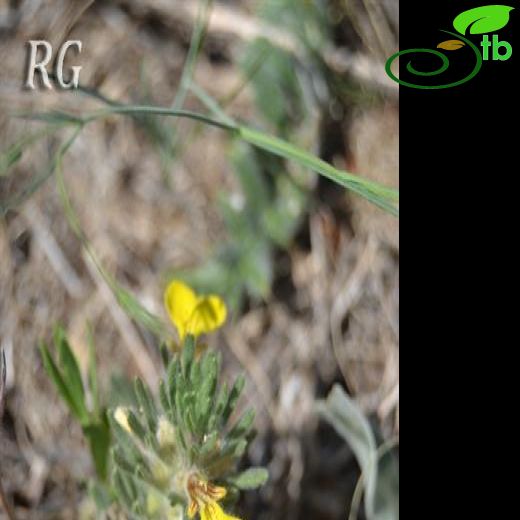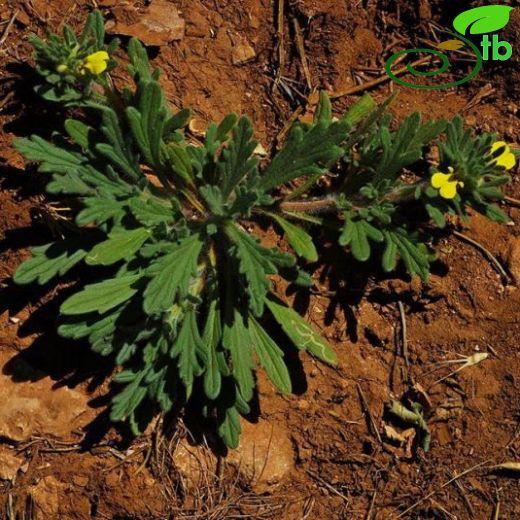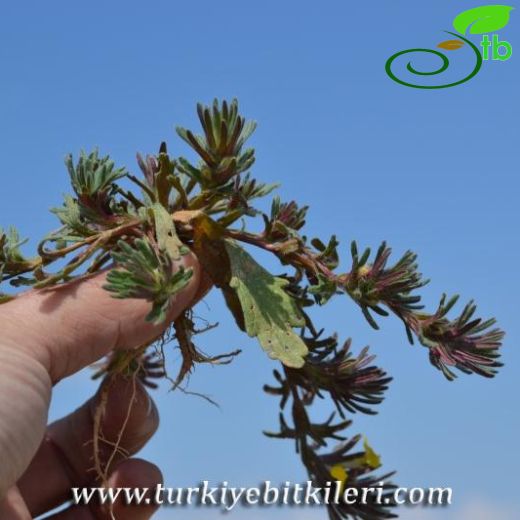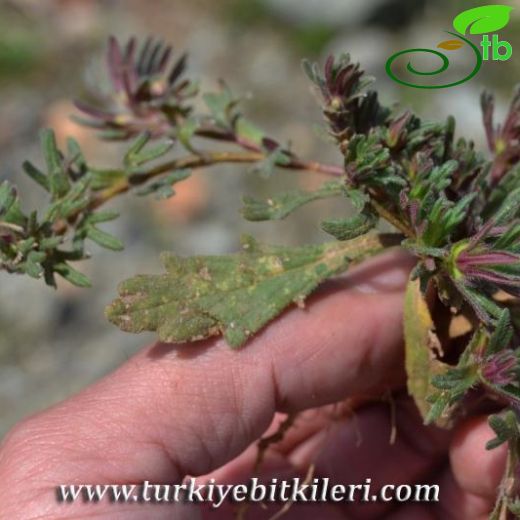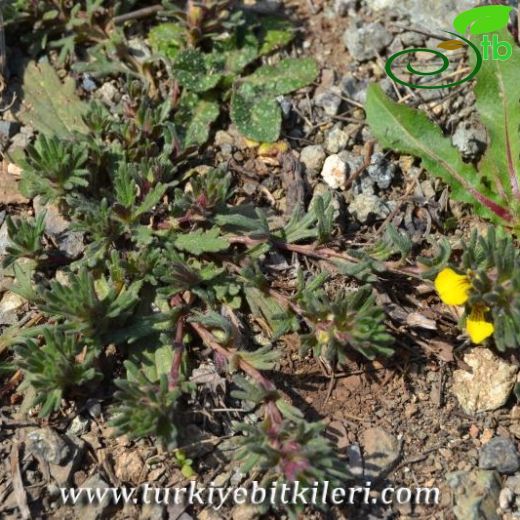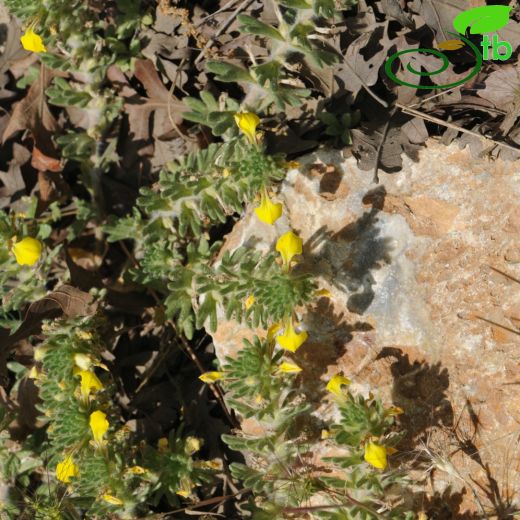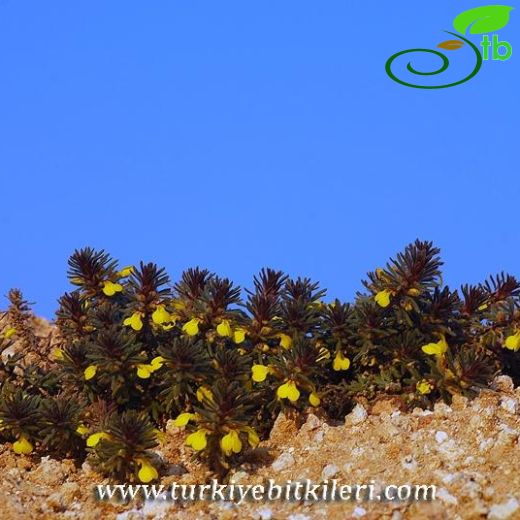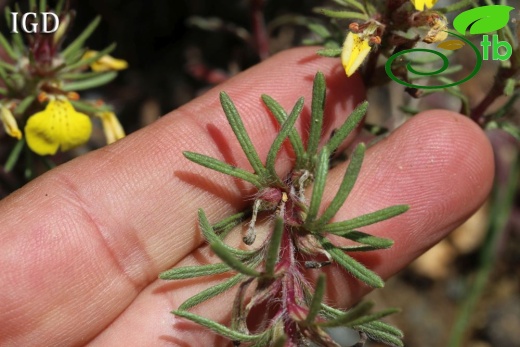Ajuga chamaepitys
Ajuga chamaepitys
Ssp chia: Acıgıcı; Ssp cuneatifolia: Kayamayasılı; Ssp cypria: Kıbrısmayasılı; Ssp euphratica: Fıratmayasılı; Ssp glareosa: Çakılmayasılı; Ssp laevigata: Kelmayasıl; Ssp mardinensis: Mardinmayasılı; Ssp mesogitana: Bayırmayasılı; Ssp palaestina: Dallımayasıl; Ssp rechingeri: Yünmayasılı
Perennial, biennial or annual herbs, very variable. Stems prostrate or ascending, variously hairy or glabrous. Cauline leaves cuneate to cuneate-oblong, shortly 3-lobed to deeply 3-partite, hirsute, villous, lanate or sub-glabrous; floral leaves usually somewhat more deeply divided. Verticillasters 2-flowered. Calyx 4-6 mm, teeth 0.5-1 x tube. Corolla yellow , 8-30 mm, upper lip short and emarginate, middle lobe of lower lip bilobed. Stamens exserted beyond reduced upper lip. Nutlets 2.5-4 mm, transversely rugulose, often foveolate towards apex. Calcicole.
1. Stems glabrous, usually purple; cauline leaves broadly oblong and often sheathing below the linear lobes; inflorescence usually a terminal panicle; corolla 20-25 mm b. subsp. laevigata
1. Stems hairy all round or at least on 2 opposite sides, usually green; cauline leaves not broadened out and ± sheathing below the lobes; inflorescence usually simple ; corolla 8-30 mm
2. Dwarf alpine plants with subterranean caudiculi and short, densely leafy shoots;lower floral leaves obtusely lobed to 1/3-1/2, shortly villous;corolla 18-22 mm d. subsp. glareosa
2. Plants not as above
3. Middle lobe of lower floral leaves linear, 6-many times longer than broad, as long as or longer than attenuate basal portion; stems spread-ing-hirsute, or shortly hairy only on 2 opposite sides ;corolla 16-23 mm a. subsp. chia
4. Stems hirsute with long stiff patent hairs on all sides var. chia
4. Stems glabrous on 2 opposite sides, retrorse-puberulent on the other two sides var. ciliata
2. Dwarf alpine plants with subterranean caudiculi and short, densely leafy shoots;lower floral leaves obtusely lobed to 1/3-1/2, shortly villous;corolla 18-22 mm d. subsp. glareosa
2. Plants not as above
3. Middle lobe of lower floral leaves linear, 6-many times longer than broad, as long as or longer than attenuate basal portion; stems spread-ing-hirsute, or shortly hairy only on 2 opposite sides ;corolla 16-23 mm a. subsp. chia
4. Stems hirsute with long stiff patent hairs on all sides var. chia
4. Stems glabrous on 2 opposite sides, retrorse-puberulent on the other two sides var. ciliata
3. Middle lobe of lower floral leaves broadly ovate to linear-oblong, less than 6 x longer than broad, shorter than to as long as narrowed basal portion; stems usually woolly or sometimes pubescent-canescent all round; corolla 8-25 mm
5. Lower floral leaves divided to halfway into linear-oblong lobes; corolla 15-20 mm
6. Prostrate plant of stony slopes or disturbed ground; flowering stems sparsely to densely villous, usually branched; basal leaves linear-oblanceolate, remotely crenate-dentate c. subsp. palaestina
6. Plant of rock crevices; flowering stems lanate-villous, ± simple ;basal leaves narrowly obovate, subentire to crenate e.subsp. euphratica
5. Lower floral leaves divided to less than halfway; corolla 8-25 mm
7. Corolla 8-11 mm, usually drying pinkish; lower floral leaves only 8-14 mm, usually divided to 1/4 or less into short rounded to ovate-oblong lobes h. subsp. cypria
7. Corolla 12-25 mm, remaining yellow on drying; lower floral leaves 5-27 mm, divided to 1/3 to nearly halfway
8. Inflorescence columnar, the densely imbricated floral leaves having acute oblong-lanceolate lobes;corolla 12-14 mm j. subsp. rechingeri
8. Inflorescence not as above; leaf lobes obtuse; corolla 14-25 mm
9. Cauline and lower floral leaves 5-12 mm, cuneate-oblong, 3-fid to 1/4-1/2; plant canescent with short slender dense subadpressed hairs;corolla 14-20 mm i. subsp. mardinensis
9. Cauline and lower floral leaves 10-27 mm, cuneate to obtriang-ular, 3-fid to 1/3; plant lanate or patent-pilose, more robust; corolla 15-25 mm
10. Stems ± densely lanate; floral leaves lanate and greyish, cuneate or oblong-cuneate, divided into ovate to oblong lobes f. subsp. mesogitana
10. Stems patent-pilose, with many subsessile glands visible; floral leaves pilose, greenish, conspicuously glandular, broadly cuneate to obtriangular, divided into broader lobes g. subsp. cuneatifolia
5. Lower floral leaves divided to halfway into linear-oblong lobes; corolla 15-20 mm
6. Prostrate plant of stony slopes or disturbed ground; flowering stems sparsely to densely villous, usually branched; basal leaves linear-oblanceolate, remotely crenate-dentate c. subsp. palaestina
6. Plant of rock crevices; flowering stems lanate-villous, ± simple ;basal leaves narrowly obovate, subentire to crenate e.subsp. euphratica
5. Lower floral leaves divided to less than halfway; corolla 8-25 mm
7. Corolla 8-11 mm, usually drying pinkish; lower floral leaves only 8-14 mm, usually divided to 1/4 or less into short rounded to ovate-oblong lobes h. subsp. cypria
7. Corolla 12-25 mm, remaining yellow on drying; lower floral leaves 5-27 mm, divided to 1/3 to nearly halfway
8. Inflorescence columnar, the densely imbricated floral leaves having acute oblong-lanceolate lobes;corolla 12-14 mm j. subsp. rechingeri
8. Inflorescence not as above; leaf lobes obtuse; corolla 14-25 mm
9. Cauline and lower floral leaves 5-12 mm, cuneate-oblong, 3-fid to 1/4-1/2; plant canescent with short slender dense subadpressed hairs;corolla 14-20 mm i. subsp. mardinensis
9. Cauline and lower floral leaves 10-27 mm, cuneate to obtriang-ular, 3-fid to 1/3; plant lanate or patent-pilose, more robust; corolla 15-25 mm
10. Stems ± densely lanate; floral leaves lanate and greyish, cuneate or oblong-cuneate, divided into ovate to oblong lobes f. subsp. mesogitana
10. Stems patent-pilose, with many subsessile glands visible; floral leaves pilose, greenish, conspicuously glandular, broadly cuneate to obtriangular, divided into broader lobes g. subsp. cuneatifolia





